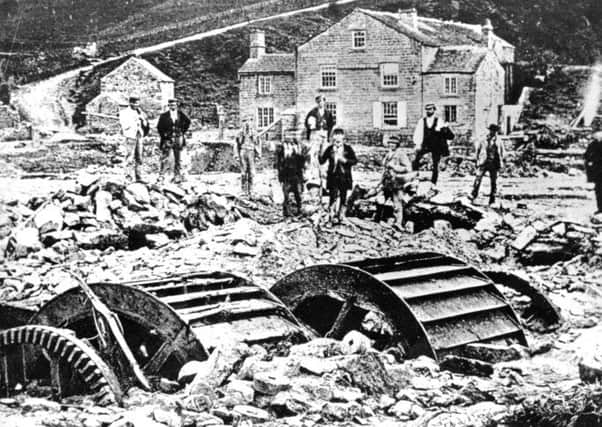Sheffield marks the North’s ‘forgotten’ tragedy


Just before midnight on March 11, 1864, a wall of water smashed its way through Sheffield after a newly built dam burst as it was being filled, leaving a trail of devastation.
Around half of those who died in the deluge were children.
But historians of the disaster say the tragedy is largely forgotten, possibly because it was “in the North and because it involved working class people”.
Advertisement
Hide AdAdvertisement
Hide AdThis weekend, enthusiasts and interested members of the public gathered at an exhibition in the village of Bradfield, just north of Sheffield, to mark the anniversary.
It is just one of a number of events over the next few days to remember the disaster, including in a wreath-laying ceremony at a memorial to the tragedy in the city centre on Tuesday.
Guided walks and church services are also talking place.
Karen Lightowler, who devotes her spare time to tracing the descendants of those who died, said: “I am passionate about the flood.
“It is this country’s worst ever man-made disaster but virtually nobody knows about it.
Advertisement
Hide AdAdvertisement
Hide Ad“It’s such a tragedy that so many people died through no fault of their own.
“If it had happened in London there would be an annual memorial for it. Everyone would know about it.
“But, because it was in the north and because it involved working class people nobody remembers it.
“That’s why I like to do my little bit.”
Bradfield parish archivist Malcolm Nunn explained how his great-great-great grandfather was William Horsfield - the farmer who first spotted a crack in the Dale Dyke dam, which had just been built to supply drinking water to fast-growing Sheffield.
Advertisement
Hide AdAdvertisement
Hide AdHours after Mr Horsfield raised the alarm the structure collapsed, allowing 650 million of gallons of water to cascade down the Loxley Valley, devastating farms and hamlets devoted to metal working.
The flood-water moved down to meet the River Don and then laid waste to large areas of the centre of Sheffield.
One body was found at Conisbrough, 18 miles downstream.
The death toll on the night was 240 but more died as a result of the diseases caused by the flood. Enthusiasts gathered today agreed the final death-toll probably exceeded 300.
Harrowing stories emerged of how many of the victims died. One person who drowned was a new-born baby washed from his mother’s arms in Bradfield. Three children died in a cellar in Sheffield while their parents were away.
More than 700 buildings and 20 bridges were destroyed.
Advertisement
Hide AdAdvertisement
Hide AdSheffield historian Ron Clayton lives at Malin Bridge, the Sheffield suburb, which was a village in 1864 .
Malin Bridge was worst hit by the flood waters, with 102 deaths. A photograph of the shattered remains of the Cleakum Inn, rebuilt later as the Malin Bridge Inn, is one of the many striking images of the disaster.
Mr Clayton said: “If you look at those photographs, Malin Bridge was ground-zero. It was devastated, whole families wiped out, buildings just washed away.
“The death toll of the flood was massive. There’s nothing else to compare with it in peacetime in terms of man-made disasters.”
Advertisement
Hide AdAdvertisement
Hide AdMr Clayton said interest in the 1864 disaster is growing but, if you mention the Great Sheffield Flood to most people in the city they still usually think of the 2007 inundation that saw many homes flooded and two people die in the water.
“We remember pit disasters and other tragedies and I think it’s only right this is remembered too,” he said.
Mick Drewry, whose book on the disaster is due out later this year, said: “It’s not even very well known about in Sheffield, never mind nationally.
“It was a major historical event and it needs to be remembered properly.”
Advertisement
Hide AdAdvertisement
Hide AdSarah Hung, from Hong Kong, said she timed her visit to relatives in the UK so she could attend the event as she is descended from some of those who died.
“It’s such a massive disaster and it’s right it’s remembered like this even though it was 150 years ago.”
ends